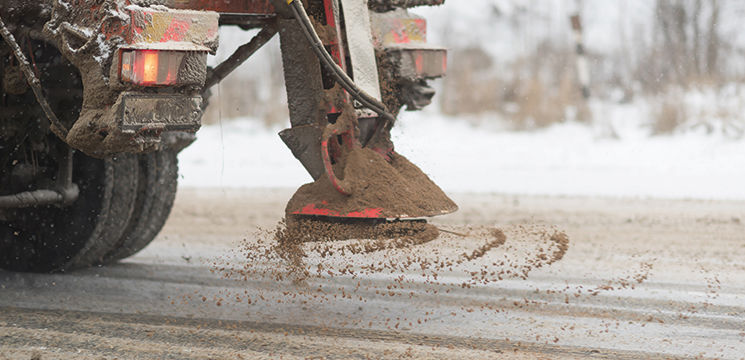Gritting common areas
If you’re in charge of managing buildings or maintaining grounds (whether you’re a residents management company (RMC), right to manage company (RTM), freeholder, or agent), it’s your duty to minimise risk for residents, visitors and contractors using the common areas. Depending on the area concerned you might need an outside contractor or, if it’s just a path and a few steps, you can provide a grit bin and ask residents to help spread it when necessary.
If you are an employer, it's your responsibility, under Regulation 12 of the Management of Health and Safety at Work Regulations, to ensure there are clear routes to access the workplace in hazardous conditions. So, putting a gritting policy into practice is recommended. This policy should be supported by practical information and the person tasked with gritting should be properly trained and equipped.
How to use grit
Clear away fresh snow with a shovel before putting down grit, ideally at the start of the day. Do not use boiling water to melt snow or ice; this will refreeze. You should apply grit sparingly to paths, pavements, roads and steps and any other areas likely to become slippery in freezing conditions.
Grit will last approximately six hours if exposed to steady motor and pedestrian traffic and will need to be reapplied to remain effective.
You should start gritting when freezing conditions are forecast, especially if paths and other common areas are already wet from rainfall. Don’t apply grit when it is raining as the salt in the grit will be washed away.
How grit works
The grit itself doesn't melt snow and ice. Instead, it mixes with moisture to produce a saline solution, which freezes at a lower temperature than water. Consequently, frost and ice can't form, even when the temperature is below freezing. It's why seawater freezes at a lower temperature than fresh water.
Follow the advice of the Health and Safety Executive (HSE)
To reduce the risk of trips and slips in wintry conditions the HSE recommends that businesses conduct a risk assessment and implement measures to manage the risk. Suggested actions include:
- Monitoring the temperature and identifying outdoor areas most likely to be affected by freezing conditions
- Taking preventative measures, such as applying grit to surfaces likely to freeze over and redirecting pedestrians away from icy or snowy areas
- If you use warning cones, remove them as soon as the hazard has passed. Otherwise, they will cease to be effective deterrents.
Myths about clearing snow and ice and your liability
There is conflicting advice concerning whether you might be held liable if someone slips as a consequence of you gritting – or not gritting – a walkway, pavement or common area.
One assertion is that you can't be sued if you leave a pavement or walkway untreated. If someone slips while walking on an icy pavement, it'll be that person's fault since it's their responsibility to take care where they walk. The other assertion is that if you grit a public area, somebody could assume it is safe and still fall.
The reality is that there is no law preventing you from clearing a public area of snow or ice. It is an offence, however, to clear snow and ice onto a road or pavement. Your duty of care concerns 'reasonably practicable tasks'. Adequate snow and ice clearance is safer than doing nothing, so you are unlikely to be held responsible if someone slips and falls.







